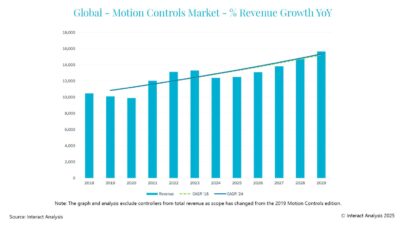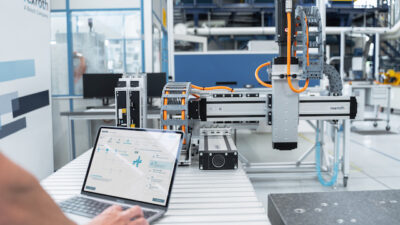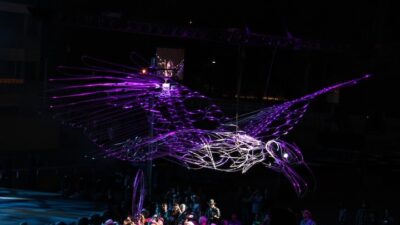Milling machine axis control system uses real-time open architecture and digital permanent magnet synchronous motor (PMSM) control, based on a high-performance PXI platform. Updated with reader comment Feb. 5.
A real-time open architecture milling machine axis control system includes vibro-acoustic signals that occur during the milling process. A laboratory stand demonstrated motor position with a field-oriented control algorithm. A digital signal processing technique of dynamic vibration and acoustic pressure signals was proposed to compensate for control milling process nonlinearity. Using field programmable gate array (FPGA) technology improves positioning thanks to increased sampling rates of controlling signals in relation to commonly implemented solutions. Motor position readings via absolute encoder were ensured to provide the best measurement resolution. Modularity and flexibility in the test stand maintain high quality.
Most control loops for electric feed drives used in computer numerical control (CNC) machines for industry are closed architecture systems. That means they were designed in a way that prevents users from making changes in the controlling algorithms of the device. Conventional cascade position control loops for electric feed drives used in CNC systems have limitations that slow the development of new solutions.
Recently, several CNC systems producers have offered quasi-open architecture machines, though these still have not met expectations of end users. Real-time open architecture control systems allow users to modify component algorithms to improve work parameters of the CNC machine to the top level of its functional model. For these reasons, there’s a lot of research on this topic. The completely new and original approach described here implements measured and digitally preprocessed signals within the control loop of the digital servodrive of the milling machine feed-drive module.
Laboratory stand
The integrated laboratory stand was based on National Instruments hardware and software solutions. Control, measurements, and digital signal processing algorithms were implemented on a PXI platform equipped with specifically dedicated modules. Position measurements of the motor were made via an EnDat 2.1 encoder module with EnDat 2.1 interface (developed by Heidenhain); vibrations and acoustic pressure signals were obtained with a high sampling rate using an NI 9234 module. A field-oriented control algorithm was executed on FPGA target (NI PXI 7854R), which helps maintain high efficiency of the code. The motor was controlled by an NI 9502 motor drive module, capable of 4 A continuous current output to drive three-phase permanent magnet synchronous motors (PMSM). The control and measuring system was connected with an autonomic one-axis feed drive to perform a series of tests.
Sound, vibration in feed drive control loop
Vibrations are an integral part of every dynamic system. They appear in feed drive for many reasons, for example: rotational speed of the servodrive, structural vibrations, and so on. Feed drives are used to position the machine tool components carrying the cutting tool and workpiece to the desired location; hence their positioning accuracy and speed determine the quality and productivity of machine tools. For these reasons, it is critical to diagnose the moment and cause of their formation. Vibration monitoring is one of the most often used methods in machine diagnostics due to its relatively low cost and simplicity of implementation.
The mechanical energy of a device transforms into acoustic energy when it contacts the air. The sound signals measured closest to a machine reveal information about the state of the process being performed. To acquire acoustic pressure signals, directional microphones are most often used. Due to the relatively low frequency band related to the axis feed drive, sound signals can be easily measured even with nonspecialized devices.
Sound and vibration measurements often are used in monitoring systems of industrial CNC machines. Their main advantage is cost in relation to the diagnostic information contained in these signals. Identification of resulting vibrations helps to improve the positioning accuracy of feed drives; acoustic pressure signals can diagnose abnormal device functionality.
Diagnostic signals for electric feed drives
The task of the digital signal processing (DSP) block added to the conventional cascade position control loop for the feed drive algorithm is to calculate extra steering signals for one/several/every regulator or setpoint value. Measurements taken during operation of the device are processed with DSP methods, and calculations both in time and frequency domain are made. Due to the former identification of parameters and behavior of the axis feed drive, abnormal conditions and unwanted states of work are known. Based on that knowledge, a special algorithm monitors sound and vibration signals from the device and calculate additional control signals for regulators when needed.
Algorithms were implemented in the FPGA module to execute the control loop in a deterministic way and as quickly as possible, which creates a real-time system. A field-oriented control (FOC) algorithm for the servodrive was used for this high-end application. FOC maintains high efficiency over a wide operating range and allows for precise dynamic control of speed and torque. Correction signals were formed based on root-mean-square (RMS) calculations and fast Fourier transform (FFT) and power spectral density (PSD) algorithms of analog measurements of sound and vibration quantities. Adequate additive signals were put into each controller equal in time to control loop execution.
Future work: System robustness
A real-time open architecture milling machine axis control system included vibro-acoustic signals that occur during the milling process to test the possibility of improving control loop execution, compared to conventional solutions. Additional signals were calculated based on sound and vibration measurements taken to help maintain a high quality of regulation. FPGA-based execution of algorithms provided high sampling rates and determinism. The purpose of the integrated laboratory stand was to prove the usefulness of correction block implementation for traditional solutions. Future work will be made in the field of improving system robustness.
– Krzysztof Pietrusewicz, DSc, is an assistant professor at West Pomeranian University of Technology, Szczecin. His work includes robust digital control of CNC feed-drive PMSM/PMLM-based modules. Paweł Waszczuk, Msc, is a PhD student there. His PhD thesis examines the problem of integrating correcting functionalities for robust control of digital servodrives. Both contribute to Control Engineering Poland. Edited by Mark T. Hoske, content manager, CFE Media, Control Engineering, [email protected].
ONLINE extras
Read more about the EnDat interface.
Reader question about openness and author reply – Added Feb. 5
A reader asked if National Instruments hardware and software can be considered as “open.” Krzysztof Pietrusewicz, one of the authors, replied, in part, that for a large number of milling machines, at present, it seems unlikely that a machine builder would use a National Instruments architecture for the control system. However, “as a researcher, I consider the NI system open because:
1) It can be freely programmed (of course with the use of NI LabVIEW).
2) Innovative solutions can be simply implemented in the area of integration of on-line DSP and condition monitoring within the motion control system. (We have patented this approach here.)
3) Hardware can be developed anyone (this option can be expensive, but you can simply develop your own NI CompactRIO measurement modules).”



